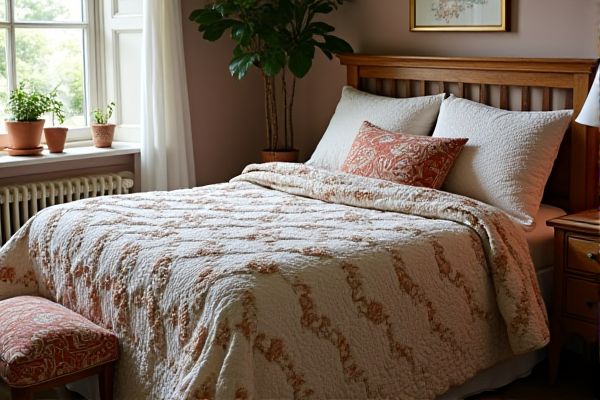
A quilt is a layered textile typically featuring intricate stitching and a warm batting core, ideal for cozy bedding, while a coverlet is a lightweight, decorative bedspread often used as a stylish top layer without much insulation. Explore the rest of the article to discover which option best suits Your bedding needs and design preferences.
Table of Comparison
| Feature | Quilt | Coverlet |
|---|---|---|
| Material | Multiple layers stitched together, often cotton with batting inside | Lightweight woven fabric, typically cotton or polyester |
| Construction | Layered with decorative stitching (quilting), includes a filling | Single layer, usually no filling, with decorative woven patterns |
| Warmth | Moderate to warm, suitable for colder weather | Lightweight, best for mild or warm climates |
| Use | Primary bed cover or extra warmth layer | Decorative bedspread or lightweight cover |
| Care | Machine washable but may require gentle cycles | Easy to wash, often machine washable |
| Design | Varied patterns, often patchwork or detailed stitching | Simple woven patterns, often minimalistic |
| Typical Weight | Heavier, due to multiple layers and filling | Lightweight, minimal bulk |
Quilt vs Coverlet: Key Differences
Quilts typically feature three layers--top fabric, batting, and backing--stitched together in intricate patterns, offering warmth and texture. Coverlets are lightweight, woven or quilted bedspreads without the thick batting layer, designed primarily for decorative purposes and mild warmth. Your choice depends on whether you prioritize insulation and comfort (quilt) or a stylish, lighter bed covering (coverlet).
What Is a Quilt?
A quilt is a multilayered textile composed of three distinct layers: a top fabric, a middle layer of batting or wadding, and a bottom fabric, all stitched together with intricate patterns. Quilts provide warmth through their insulating batting and often feature decorative stitching that enhances both texture and design. Unlike coverlets, quilts are typically thicker and more substantial, making them ideal for colder climates or as statement bedding pieces.
What Is a Coverlet?
A coverlet is a lightweight, woven bedspread typically used as a decorative layer over sheets or a blanket, providing moderate warmth without the heaviness of a quilt. Unlike quilts that feature multiple layers and intricate stitching, coverlets are usually a single layer with a simple, flat design, making them ideal for layering in warmer climates or seasons. Your bedroom decor benefits from the versatility and often textured appearance of a coverlet, adding style without extra bulk.
Materials Used in Quilts and Coverlets
Quilts are traditionally made using three layers: a top fabric layer, a middle insulating batting made from cotton, wool, or polyester, and a backing layer, all stitched together with intricate patterns. Coverlets are typically woven from cotton, wool, or synthetic fibers, often without batting, resulting in a lighter, thinner blanket designed primarily for decorative use or light warmth. The choice of materials directly influences the texture, warmth, and weight, with quilts offering more insulation due to their layered construction, while coverlets remain breathable and elegant through their woven craftsmanship.
Design and Patterns: Quilt vs Coverlet
Quilts showcase intricate designs created through piecing together multiple fabric layers, often featuring complex patterns like patchwork, applique, or elaborate stitching that adds texture and dimension. Coverlets generally have simpler, more uniform designs, typically woven or lightly quilted with consistent patterns such as diamond or geometric motifs, emphasizing a flat and smooth appearance. The detailed craftsmanship in quilts provides a rich visual and tactile experience, whereas coverlets offer a more understated, streamlined aesthetic ideal for layering.
Warmth and Functionality Compared
Quilts are typically thicker and consist of multiple layers of fabric and batting, providing superior warmth, making them suitable for colder climates. Coverlets are thinner, often used as decorative bed coverings or lightweight options in warmer weather. Functionally, quilts offer insulation and comfort, while coverlets prioritize aesthetic appeal and serve as a versatile layering piece.
Best Uses for Quilts
Quilts excel in providing warmth and comfort due to their thick, layered construction, making them ideal for colder climates or as a cozy bedding option during winter. Their intricate stitching and decorative patterns also serve well as statement pieces or heirloom items that enhance bedroom aesthetics. You can easily use quilts for layering on beds or as versatile throws for added style and functionality in living spaces.
Best Uses for Coverlets
Coverlets are lightweight bedding options ideal for layering during warmer months or adding a decorative touch to your bed without extra warmth. Their thin construction makes them perfect for use in transitional seasons or as a stylish overlay to complement your existing quilts or comforters. You can enhance your bedroom's aesthetic with coverlets while keeping your bedding versatile and easy to maintain.
Care and Maintenance Tips
Quilts require gentle washing with mild detergent in cold water to preserve their intricate stitching and fabric textures, while coverlets, often lighter and less detailed, can usually be machine washed on a delicate cycle without special treatment. To maintain the longevity of both, avoid harsh chemicals and excessive heat during drying, opting instead for air drying or low-heat settings. Proper care ensures your bedding retains its softness, color, and structural integrity over time.
Choosing Between a Quilt and a Coverlet
Choosing between a quilt and a coverlet depends on warmth needs and design preferences; quilts provide thicker, insulated layering with intricate stitching patterns, while coverlets offer lighter weight and a smooth, decorative finish. Quilts often feature multiple fabric layers and detailed patchwork ideal for colder climates, whereas coverlets typically serve as aesthetic bedspreads suitable for mild temperatures. Evaluating factors like seasonal use, fabric material, and bedroom style helps determine the best option for comfort and decor.
 homyna.com
homyna.com